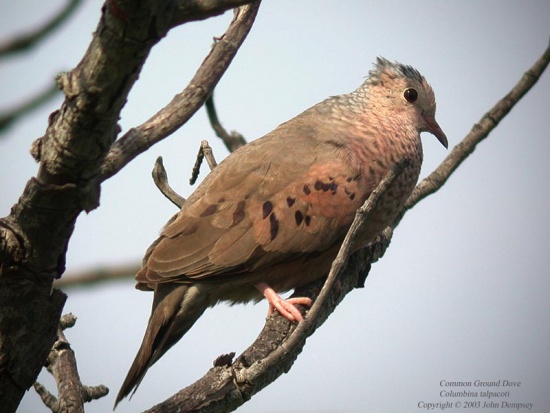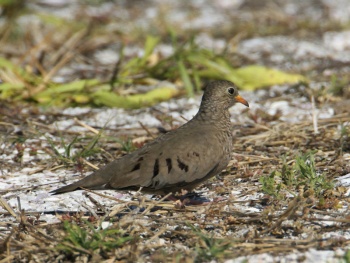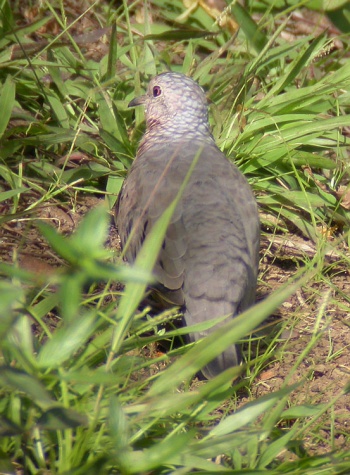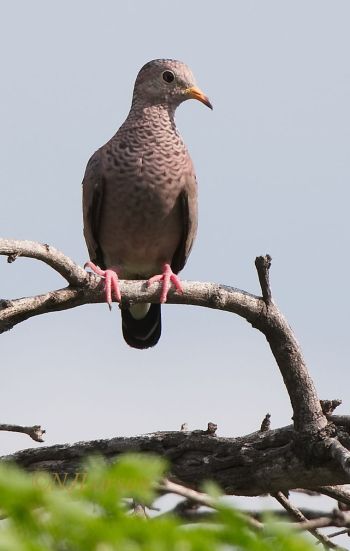m (Common Ground-Dove moved to Common Ground Dove) |
Sbarnhardt (talk | contribs) (Add subspecies ''albivitta'' image by njlarsen to Habitat, Edit njlarsen nigrirostris size to 350px from 300px) |
||
| (3 intermediate revisions by 2 users not shown) | |||
| Line 1: | Line 1: | ||
| + | [[Image:Common_Ground_Dove.jpg|thumb|550px|right|Subspecies ''insularis''<br />Photo © by {{user|jdbirdman|jdbirdman}}<br />[[Cuba]], 2003]] | ||
;[[:Category:Columbina|Columbina]] passerina | ;[[:Category:Columbina|Columbina]] passerina | ||
| − | |||
| − | |||
==Identification== | ==Identification== | ||
| − | + | [[Image:608-05565fg2 Female Eastern Common Ground-Dove.jpg|thumb|350px|right|Female<br />Photo © by {{user|bobsofpa|bobsofpa}}<br />Fort DeSoto Park, [[Florida]], [[USA]], April 2008]] | |
| + | 16-18 cm (6¼-7 in)<br/> | ||
Wt. 32g (1oz) | Wt. 32g (1oz) | ||
*Tiny | *Tiny | ||
| Line 12: | Line 12: | ||
*Centrally brown tail with black edges and white corners | *Centrally brown tail with black edges and white corners | ||
*Orange bill tipped black | *Orange bill tipped black | ||
| + | |||
'''Male'''<br /> | '''Male'''<br /> | ||
*Pink head, neck and breast | *Pink head, neck and breast | ||
| Line 23: | Line 24: | ||
Flight is fast and direct, with regular beats and an occasional sharp flick of the wings that are characteristic of pigeons in general. | Flight is fast and direct, with regular beats and an occasional sharp flick of the wings that are characteristic of pigeons in general. | ||
==Distribution== | ==Distribution== | ||
| + | [[Image:7427Common-ground-dove-DSCN2079.jpg|thumb|350px|right|Subspecies ''nigrirostris'' <br />Photo © by {{user|njlarsen|njlarsen}}<br />[[Dominica]], August 2004]] | ||
It is a resident breeder from [[Bermuda]], through the southmost [[USA]], [[Mexico]] and the Caribbean, to [[South America]], and is found as far south as northern [[Brazil]]. | It is a resident breeder from [[Bermuda]], through the southmost [[USA]], [[Mexico]] and the Caribbean, to [[South America]], and is found as far south as northern [[Brazil]]. | ||
| + | |||
==Taxonomy== | ==Taxonomy== | ||
| − | + | ====Subspecies==== | |
| − | + | There are 18 subspecies<sup>[[#References|[1]]]</sup> | |
| − | + | [[Image:Common Ground Dove L-R male-female in Ackee Tree Montego Bay Jamaica.jpg|thumb|350px|right|Male and Female, subspecies ''jamaicensis'' <br />Photo © by {{user|Stanley+Jones|Stanley Jones}}<br />Montego Bay, Cornwall State, St. James Parish, [[Jamaica]], November 2010]] | |
| − | ====Subspecies<sup>[[#References|[1]]]</sup> | ||
*''C. p. passerina '': Coastal south-eastern [[US]] ([[South Carolina]] to [[Florida]] and south-eastern [[Texas]]) | *''C. p. passerina '': Coastal south-eastern [[US]] ([[South Carolina]] to [[Florida]] and south-eastern [[Texas]]) | ||
*''C. p. pallescens'': Arid south-western [[US]] to [[Guatemala]] and [[Belize]] | *''C. p. pallescens'': Arid south-western [[US]] to [[Guatemala]] and [[Belize]] | ||
| Line 47: | Line 49: | ||
*''C. p. quitensis'': Central [[Ecuador]] (Río Guaillabamba to Riobamba) | *''C. p. quitensis'': Central [[Ecuador]] (Río Guaillabamba to Riobamba) | ||
*''C. p. griseola'': Extreme southern [[Venezuela]] to the [[Guianas]] and eastern [[Brazil]] | *''C. p. griseola'': Extreme southern [[Venezuela]] to the [[Guianas]] and eastern [[Brazil]] | ||
| + | |||
==Habitat== | ==Habitat== | ||
| − | + | [[File:Common-Ground-Dove_Subspecies-albivitta_NIELS.jpg|thumb|350px|right|Subspecies ''albivitta''<br />Photo © by {{user|njlarsen|NJ Larsen}}<br /> El Camarones, Guajira, [[Colombia]], 28 August 2023]] | |
| + | Dry sandy scrub, fields, forest edge, woodland with developed open areas, farms, open country and towns. | ||
==Behaviour== | ==Behaviour== | ||
| + | [[Image:Common Ground DoveSJ.jpg|thumb|350px|right|Subspecies ''pallescens''<br />Photo © by {{user|Stanley+Jones|Stanley Jones}}<br />Laguna Seca Ranch, north of Edingburg, Hidalgo County, [[Texas]], [[USA]], April 2019]] | ||
| + | ====Diet==== | ||
| + | Their main diet consists of a variety of small seeds from grass, weeds and also pine and sedge seeds. Apart from this there is little more known. | ||
====Breeding==== | ====Breeding==== | ||
| − | + | They build a flimsy stick nest in a tree. Their clutch contains two white eggs. | |
==References== | ==References== | ||
| − | #{{Ref- | + | #{{Ref-Clements6thAug18}}#Handbook of the Birds of the World Alive (retrieved May 2019) |
{{ref}} | {{ref}} | ||
==External Links== | ==External Links== | ||
| − | {{GSearch|Columbina | + | {{GSearch|"Columbina passerina" {{!}} "Common Ground Dove"}} |
| + | {{GS-checked}}1 | ||
<br /> | <br /> | ||
| − | + | <br /> | |
| − | [[Category:Birds]] [[Category:Columbina | + | |
| + | [[Category:Birds]] [[Category:Columbina]] | ||
Latest revision as of 15:52, 13 November 2023
- Columbina passerina
Identification
16-18 cm (6¼-7 in)
Wt. 32g (1oz)
- Tiny
- Short-tailed
- Grey-brown back and upperwings
- Black spotting on wing coverts
- Scaly appearance on breast and head
- Centrally brown tail with black edges and white corners
- Orange bill tipped black
Male
- Pink head, neck and breast
- Pink, unscaled belly
- Blue nape
Female & Immature
- Light grey where male is pink
- Grey nape
Flight
In flight, the underwings show extensive chestnut colouration. Flight is fast and direct, with regular beats and an occasional sharp flick of the wings that are characteristic of pigeons in general.
Distribution
It is a resident breeder from Bermuda, through the southmost USA, Mexico and the Caribbean, to South America, and is found as far south as northern Brazil.
Taxonomy
Subspecies
There are 18 subspecies[1]
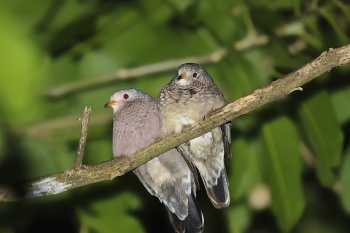
Photo © by Stanley Jones
Montego Bay, Cornwall State, St. James Parish, Jamaica, November 2010
- C. p. passerina : Coastal south-eastern US (South Carolina to Florida and south-eastern Texas)
- C. p. pallescens: Arid south-western US to Guatemala and Belize
- C. p. socorroensis: Socorro Island (Revillagigedo Islands off western Mexico)
- C. p. neglecta: Honduras to Costa Rica and Panama
- C. p. bahamensis: Bermuda and Bahamas (except Inagua Island)
- C. p. exigua: Great Inagua Island (southern Bahamas) and Mona Island (Puerto Rico)
- C. p. insularis: Cuba, Isle of Pines, Cayman Islands, Hispaniola and adjacent islands
- C. p. jamaicensis: Jamaica
- C. p. navassae: Navassa Island (off south-western Hispaniola)
- C. p. portoricensis: Puerto Rico, Mona, Culebra and [[Virgin Islands (except St. Croix)
- C. p. nigrirostris: St. Croix and northern Lesser Antilles
- C. p. trochila: Martinique (Lesser Antilles)
- C. p. antillarum: Southern Lesser Antilles (St. Lucia and Barbados to Grenada)
- C. p. albivitta: Northern Colombia, northern Venezuela, Netherlands Antilles and Trinidad
- C. p. parvula: Central Colombia (upper Magdalena Valley)
- C. p. nana: Western Colombia (Cauca Valley and arid upper Dagua Valley)
- C. p. quitensis: Central Ecuador (Río Guaillabamba to Riobamba)
- C. p. griseola: Extreme southern Venezuela to the Guianas and eastern Brazil
Habitat
Dry sandy scrub, fields, forest edge, woodland with developed open areas, farms, open country and towns.
Behaviour
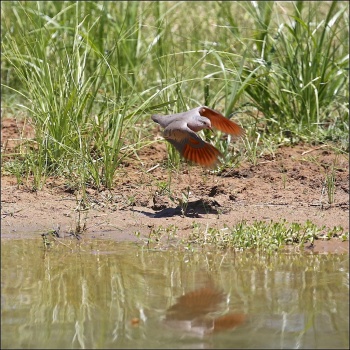
Photo © by Stanley Jones
Laguna Seca Ranch, north of Edingburg, Hidalgo County, Texas, USA, April 2019
Diet
Their main diet consists of a variety of small seeds from grass, weeds and also pine and sedge seeds. Apart from this there is little more known.
Breeding
They build a flimsy stick nest in a tree. Their clutch contains two white eggs.
References
- Clements, J. F., T. S. Schulenberg, M. J. Iliff, D. Roberson, T. A. Fredericks, B. L. Sullivan, and C. L. Wood. 2018. The eBird/Clements checklist of birds of the world: v2018. Downloaded from http://www.birds.cornell.edu/clementschecklist/download/
- Handbook of the Birds of the World Alive (retrieved May 2019)
Recommended Citation
- BirdForum Opus contributors. (2025) Common Ground Dove. In: BirdForum, the forum for wild birds and birding. Retrieved 4 April 2025 from https://www.birdforum.net/opus/Common_Ground_Dove
External Links
GSearch checked for 2020 platform.1




